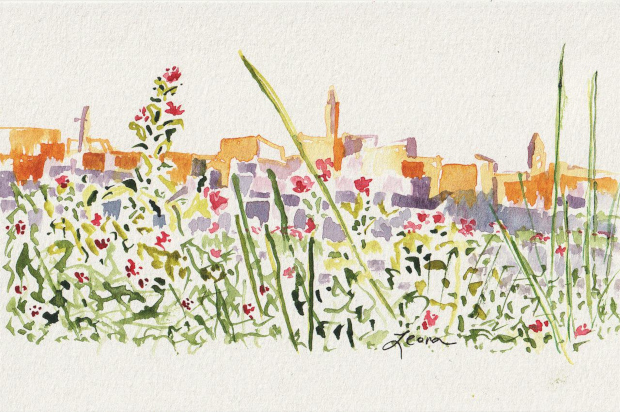
My last visit to Jerusalem was almost ten years ago. I photographed some red flowers billowing in front of the Old City of Jerusalem.
A few days I was looking for inspiration. I found a printout of the photo I had taken. I thought about shapes, colors, and composition. I wanted to capture the beautiful Jerusalem light and bring a little joyous color to my viewers.
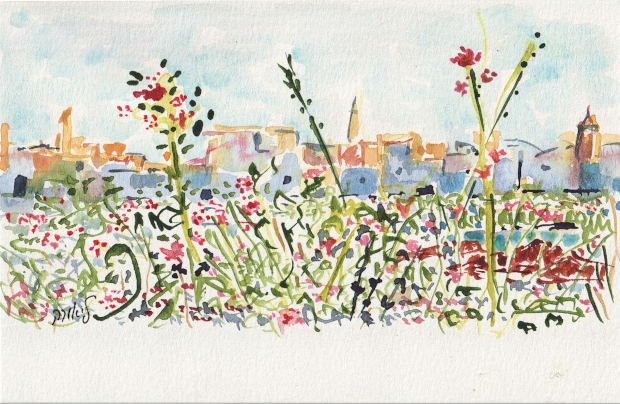
I hope you enjoy these watercolors.
And to end off, here is a shofar. We approach the New Year of 5786. The shofar tells it is time to do teshuva (repentance). May we all be blessed with a year of happiness, health, prosperity, and good deeds.
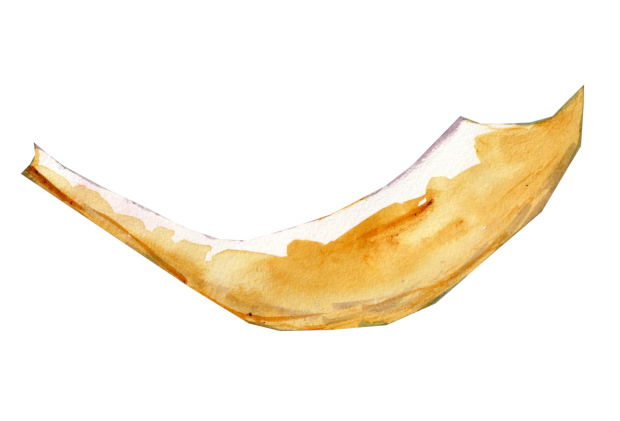
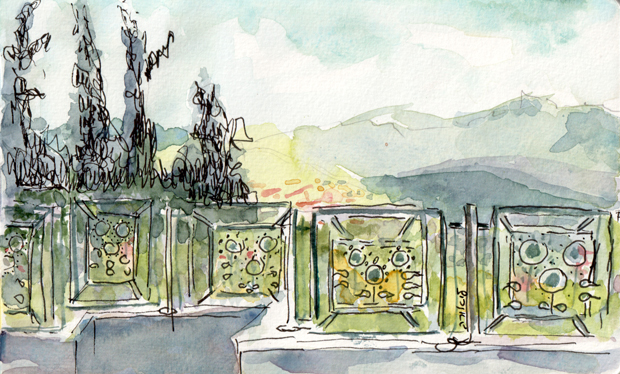
In June 2024 we visited the Galil (Galilee in English), the region in the north western part of Israel, west of the Golan Heights. Some of the places we visited were Beit Keshet, Tsefat, Tiberias, Yodfat, and Maalot. Pictured above is the illustration of the view from my friend’s house in Maalot.
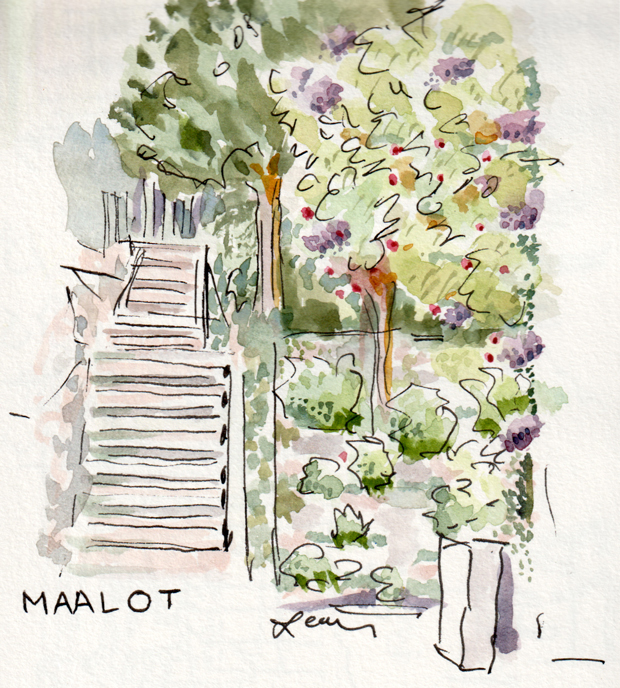
In Maalot my friend and I went on an Maalot sketch crawl. Maalot is hilly. The name Maalot means “steps.” We walked down her block and stopped at some long steps, a common scene in Maalot. The jacaranda tree was in bloom, so I was attracted to that spot. I drew first with my black uniball pen. Next I added some color.
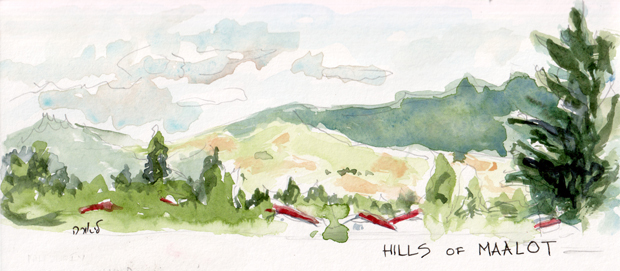
This is another scene of Maalot. The hills around were peaceful and calm.
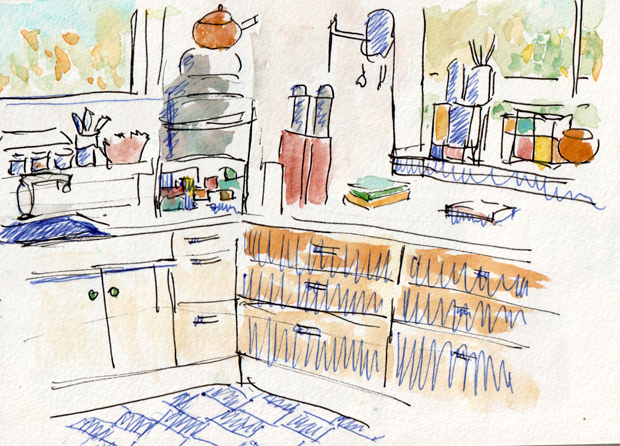
Yodfat is a small community on top of a hill. Historically, it is famous for a Roman siege of Yodfat that took place many years ago. We stayed in a house with many amenities, especially in the kitchen. When I woke up in the morning, I went for a walk all around the village. After a while, it started to get hot, so I came into the air-conditioned kitchen, took out my paints, and began to draw. I drew a corner counter with some windows. I added the ballpoint pen marks later.
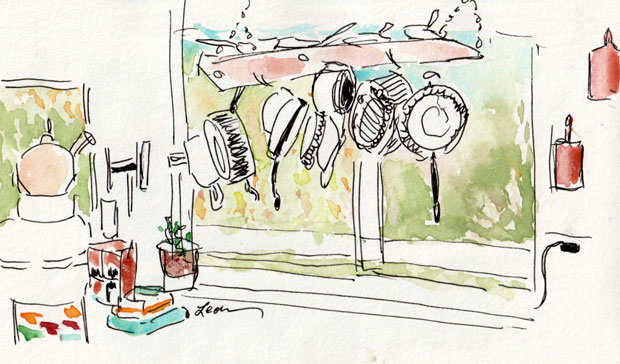
Pots and pans are a lot of fun to draw and paint.
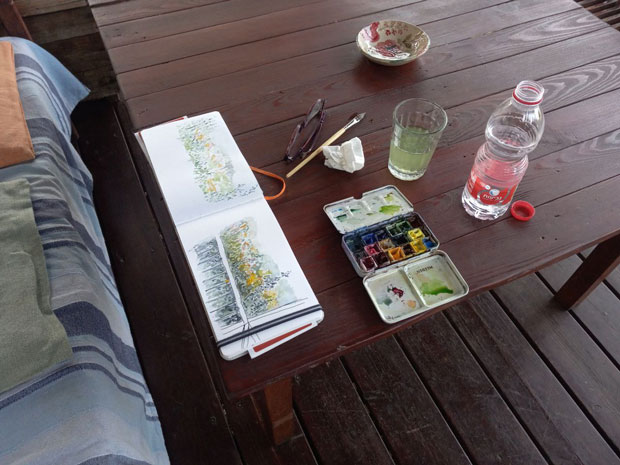
I spent the early morning in Beit Keshet with my paints and the Galil scenery.
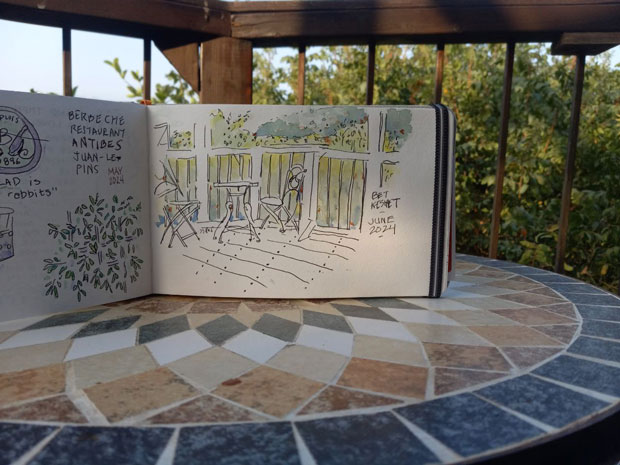
The Beit Keshet cottage had a lovely back porch with an amazing view. I loved the little table in the corner.

In December 2017 we visited the old market (known in Hebrew as a shuk) in Jerusalem called Mahane Yehuda. On a Friday the market is bustling: you can buy fruit, chocolate, wine, baked goods, fish, spices, meat and more! On a Saturday night the place converts into little bars and places to eat. We also visited on Saturday night, but because of the crowds and a broken oven in one restaurant, we ended eating a meal back on Emek Refaim Street, near where we were staying.

My husband bought some wine and some nuts for our hosts that were visiting on Shabbat. My daughter bought some chocolate in a bag. Each little chocolate candy said: “Hatan v’ Kalah” – Groom and Bride. This was because our excuse for visiting Israel was the wedding of a relative. She gave the candies to her class members upon return to the U.S.

I did not explore the spices carefully, but I am sure I would find some that are unfamiliar. The sign on the left by the rose spices says: “Please do not touch with your hands!!! Thank you!”
Have you ever visited an old market? What did you buy? What did you see?
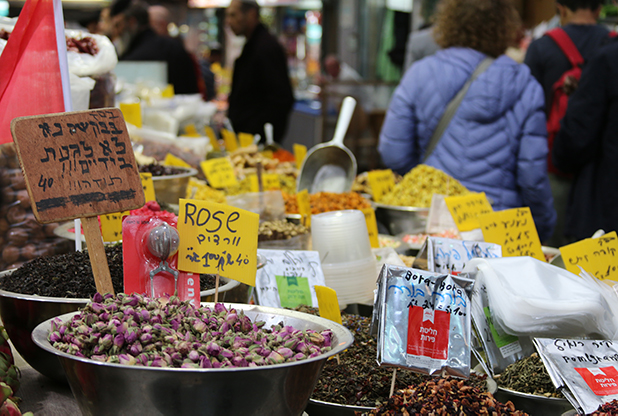

Last week on May 12 Israel celebrated its 68th birthday. And since I was working, I missed our local celebration (here’s a local Edison parade from a few years ago). Well, now I have a little time; I can share with you a few more photos from our January/February trip to Israel.
We went to visit my niece who teaches high school English in an international school north of Tel Aviv. The high school is in a youth village called HaKfar HaYarok – literally, the Green Village. Above is a picnic table with a pot of flowers. Wouldn’t you like to study math or social studies in February while sitting at a sunny picnic table?
Old City of Jerusalem, inside Jaffa Gate entrance

Here’s my daughter inside the Old City of Jerusalem, right near the Jaffa Gate.

And here’s a similar photo inside the Old City of Jerusalem – how is this different from the one above?
Hula Valley, Galil, Israel Views

Ah, birds in flight – probably cranes – at the Hula Valley nature reserve (previous post on this blog).

Even more birds in flight – how they fill the Hula Valley skies.

In many spots in the Hula Valley you can see the Golan Heights off to the east. Here’s a dramatic photo of the Heights rising over the farms below. Before 1967 when Israel captured the Golan Heights in a defensive war, Syrian soldiers used to fire shots from the mountains down on the farmers below.
Back to Jerusalem

These two photos (above and below) are both Jerusalem shots. The carnation in a pot is located in the quaint neighborhood of Yemin Moshe, a “suburb” of the Old City of Jerusalem. It was built in the late 19th century. I understand buying a home there now would cost you quite a pretty penny (can you afford a yacht?).

Finally, this is a cute bird diving into a little fountain with Jerusalem lions. It was near our hotel (the Inbal), north of the old train station that was renovated (and we did not get a chance to see – lots to do for our next visit).
Because there is some nature in this post (can you spot some?), I am including this post in Nature Notes:

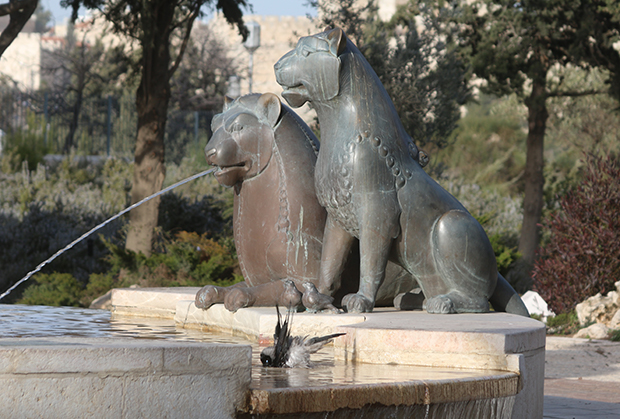

One of the cool things about visiting Israel at the end of January was in all different sorts of places I found flowers! I am not used to flowers in January; I grew in the Boston area where what one found on the ground was usually snow. I photographed a variety of Israeli flowers in January. The yellow daisy above was somewhere near Tel Aviv.

Here is a similar yellow flower – also north of Tel Aviv, in a different spot. We had visited my niece who is teaching English in an international high school. I am wondering if keen-eyed nature bloggers can suggest difference between these two daisy-like flowers.

These lovely dark pink flowers were growing in a garden in Jerusalem right behind Yemin Moshe.

This shot of the dark pink flowers focuses on the Old City of Jerusalem behind the garden. It was a lovely view.

This pink flower with thick leaves was in a location north of Tel Aviv. In Israel one can often find flowers and plants with thick leaves; the thick leaves store water, and almost no water falls in the summer, so the plants have to store it up to stay alive.

This is some kind of thick leaf vegetation by the Mediterranean sea north of Tel Aviv.

I photographed this thistle in the Hula Valley. Contrast this green look of the thistle in a winter with abundant rain with the thistle I photographed back in 2008 in a drought.

A tiny wildflower peaked out at me when I visited the backyard of a friend who lives in Har Adar, Israel, a beautiful village on top of a tall hill, the tallest hill in the west Jerusalem hills. Maybe it’s some kind of geranium? (See cranesbill that grows in front of my house, as a contrast). There was also abundant rosemary growing in the area. When I grow rosemary in New Jersey, it almost always dies in the winter. In the Jerusalem area, even the winters are cold, they are not as cold as in New Jersey, so the rosemary spreads and makes itself known. How nice to have rosemary naturally in your backyard!

Enjoy some yellow wildflowers I found by Tel Azeka (a few minutes by car west of Beit Shemesh).
It’s been a while since I last posted. In the Nature Notes blogging world, something awful happened last month. I was hoping to get a comment on my last post from one of my favorite bloggers, EG Wow (real name: Tina Forrester). I learned to my horror that Tina and her husband had died in a terrible car accident. If you have never visited her blog, oh, sigh, you are in for a treat. But you will never really learn how warm and friendly her comments were when she commented on other blogs. May her family and friends know no more sorrow.
For more Nature Notes:

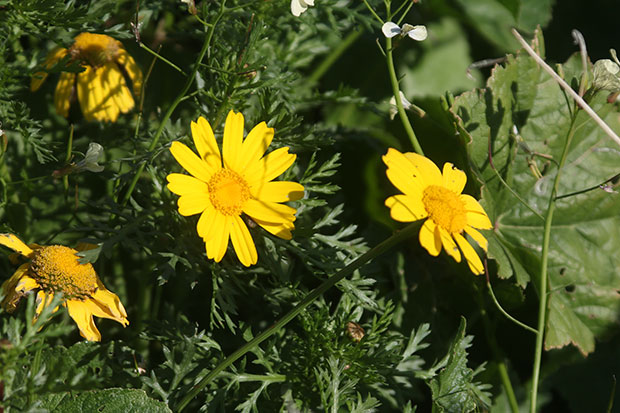

Among the birds I saw at the Hula Valley in Israel: gallinule (moorhen), lapwing, egret, crane, pelican. My daughter saw a small blue bird fly by quickly twice – this may have been a kingfisher.
A bit of history about this magical (to me, at least) place in northern Israel:
Back in the 1950’s the malaria-ridden swamps of the Hula Valley were drained. However, this caused ecological damage. From the leaflet of the Hula Agamon Lake: “Over the years the peat earth that is typical of the Hula(organic earth the the remains of plants and animals) dried up, broke up, sunk, and even started to burn underground. The worst thing was that the phosphates and nitrates in the earth were washed into the Kinneret and polluted its waters.” In the 1990’s earth was restored; the project included digging canals that allowed the control of water in the area.
One of the major benefits of the 1990’s work was this ornithological spot, unique in the world. Over this area twice a year no less than 500 million birds migrate.
Learn more here: http://www.agamon-hula.co.il/?lang=en_US

This bird is a spur-winged lapwing or spur-winged plover.

Here is a gallinule – note that orange beak.

Here my daughter is standing by a white nesting box. We didn’t see any birds near the box, but the box reminded me of the boxes we saw at Cape May. According to the literature we were handed when we entered, these are for white owls. It seems the white owls eat voles, and voles do damage agriculturally, so eliminating the voles is a good thing.

I got some good photos of the handsome egret.


I believe this is an egret in flight.

The most abundant bird species in the area are the cranes.

Those spoonbills sure have funny beaks. (see https://twitter.com/hulakkl/status/498657479324991488)

This furry-looking guy is a muskrat.

Ah, after rain on and off, it’s nice to be rewarded with a rainbow!

Even better, here is the rainbow with birds flying by.
Notes on visiting Hula Agamon Lake: don’t do what we did and try to walk the whole thing. We should have rented the golf cart. It’s a big area! There are also bikes available to rent. It would be great to visit during a migratory period, but I feel fortunate that I got there at all.
For more nature notes, visit:

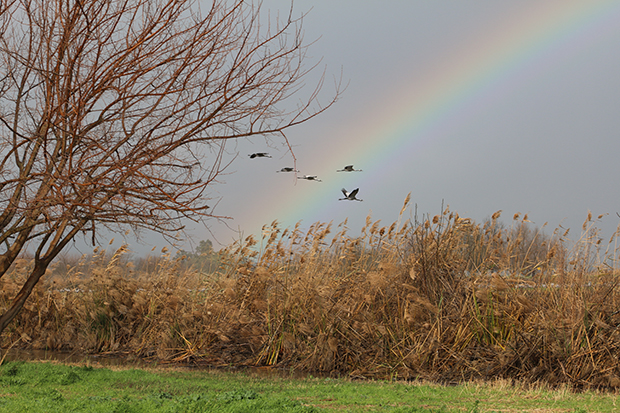

I have always wanted to see the spring flowers in bloom in Israel, and on my recent trip, I had that opportunity. Too bad my daughter thought the day too cold for an outdoor trip, but to me it felt like April in Boston.

There is a song in Hebrew for these beautiful red flowers that show up all over the landscape in February in Israel: kalaniyot. The English name for these flowers is anemones.

The ones I saw were not yet open. I asked my son who is spending the year in Gush Etzion if he saw any red flowers, and he said, oh yeah, he did see a lot of red flowers. Probably wouldn’t have noticed if I hadn’t said anything.

This is rakefet – cyclamen in English. Turns out there is a song for rakefet as well!

This is an almond blossom. That one, too, comes with a song: Hashkedia porahat. In about one month parts of Israel will be full with these blossoms.

I saw this chicory flower as well. I think the Hebrew is olesh.

There is history in the park as well. Supposedly, somewhere in the plains David battled the Philistines.

I’m not sure what city that is in the background, but when you reach the top of Tel Azeka on a clear day, you can see far in many directions. I think the general area is called Emek HaEla – Valley of Ela.
For more Nature Notes:

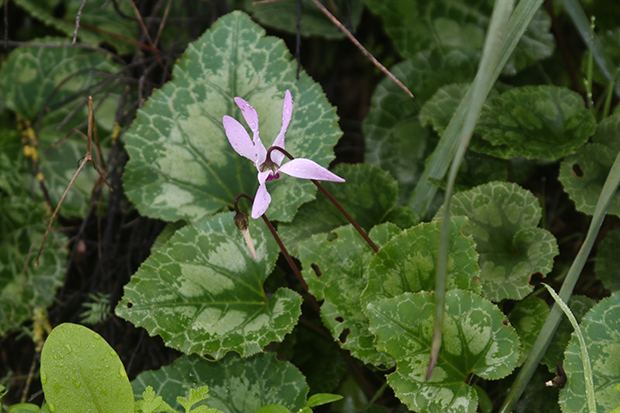

Looking back to my trip to Israel in May, here is a street scene with a Jerusalem light rail train. And lots of people. It’s Thursday night, so many people have finished work for the week.
This is actually the newer section of Jerusalem. The old city can be seen on this post, and if you like really, really old, visit The City of David.
Thursday Challenge theme is MONOCHROME (Black and White, Sepia, Old Looking,…).

It is Jewish holiday season, and ideally, I would be writing a lovely post about how the Jewish holidays are related to the seasons. In reality, I feel I am constantly preparing for the next holiday (in between having more than plenty of web work). The flower above is one of the gerber daisies my daughter gave me for Mother’s Day (with my husband’s help), and I have managed to keep it alive for the whole summer. Yay, me.
The upcoming holiday this week is called Sukkot, and we do indeed interact with nature. Here is the little booth called a sukkah that we eat meals in for seven days. We cover the top of the sukkah with light natural material called schach, and through this natural material we can sometimes see stars at night. Some people actually sleep in their sukkah.

Here are some of the decorations inside our sukkah. This is from last year – on Wednesday, it will be a mad rush to finish cooking and decorate the sukkah. In New Jersey, it often rains, so we don’t want to decorate too early. Hard enough to keep the decorations going.

This was our old sukkah, that we no longer have. It took too long to put up, so my husband gave it away. We now have a pre-fab sukkah, but I can’t paint the walls. I have to decorate with this velcro tape. I don’t enjoy that as much.
As this post is related to nature, here are some not yet shared nature photos from Israel:

Those are rocks on the top of Mount Meiron. Learn about my hike on Mount Meiron.

Love these delicate pink flowers from Mount Meiron. No idea what they are. Any guesses? Update: might be a bindweed – convolvolus oleifolius.

These trees had bright red blooms in front of the Tel Aviv Museum last May. Any guesses? Flame tree (Delonix regia)? Seems quite similar to the red trees in this Tel Aviv image. Tel Aviv in late May probably has a similar climate to southern California (maybe warmer and more humid).
Getting back to Jewish holidays and nature, the holidays follow the lunar calendar. So the moon is important. Tonight my daughter noticed the moon looked quite full, but it’s not quite the 15th of the month. It’s 13 Tishrei, so I suppose that is close. This year Thanksgiving and Chanukah will coincide, but according to this post, it will not happen again until … year 79,811. Will you be around to celebrate?
For more Nature Notes:


What do these photos of Jaffa Street (Rechov Jaffo) in Jerusalem and (below) one of the Moorlyn Theater in Ocean City, New Jersey have in common? They were both taken as the day moved away from dawn (Moorlyn Theater) or towards dusk (Jaffa Street shots). If you photograph closer to dusk or dawn, you will often capture beautiful, golden light. Back in 2009, a reader described, regarding a photo of the U.S. Consulate in Jerusalem, “the late afternoon quality of the light.” Ever since then, I’ve been more conscious of capturing photos during those golden hours of the day.

The Moorlyn Theater is on the boardwalk in Ocean City, New Jersey. They feature both movies and live shows. This photo was taken the morning my daughter and I woke early for sunrise.

Here is another shot of Jaffa Road in Jerusalem on a late Thursday afternoon in May. Note the tracks for the lightrail and the many people walking the streets. Thursday night in Jerusalem is a bit like the American Saturday night, as people usually don’t have work or school the next day. There is a sharp contrast of the golden basking glow of the apartment buildings and the shadows of the street area.
For more skies, visit Skywatch Friday. Hoping to link this up to Toby’s Whimsical Windows, Delirious Doors as well.

































































